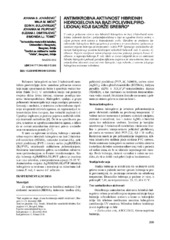Приказ основних података о документу
Antimicrobial activity of hybrid hydrogels based on poly(vinylpyrrolidone) containing silver
Antimikrobna aktivnost hibridnih hidrogelova na bazi poli(vinilpirolidona) koji sadrže srebro
| dc.creator | Jovašević, Jovana S. | |
| dc.creator | Mićić, Maja M. | |
| dc.creator | Suljovrujić, Edin H. | |
| dc.creator | Filipović, Jovanka M. | |
| dc.creator | Dimitrijević, Suzana | |
| dc.creator | Tomić, Simonida | |
| dc.date.accessioned | 2021-03-10T11:18:02Z | |
| dc.date.available | 2021-03-10T11:18:02Z | |
| dc.date.issued | 2010 | |
| dc.identifier.issn | 0367-598X | |
| dc.identifier.uri | http://TechnoRep.tmf.bg.ac.rs/handle/123456789/1624 | |
| dc.description.abstract | New hybrid hydrogels were prepared by radical copolymerization of 2-hydroxyethyl methacrylate, itaconic acid, poly(vinylpyrrolidone) and silver salt. FTIR spectroscopy has confirmed binding of silver particles in hydrogels. Swelling studies performed in in vitro conditions showed dependence on PVP content and temperature. It can be seen that the antimicrobial activity of the Ag/P(HEMA/IA)PVP hybrid hydrogels depends on the PVP moiety and with the increase of PVP content the microbial contamination is more efficiently reduced. The best sensitivity was obtained for the polymers tested for antimicrobial activity against the yeast C. albicans, one of the most commonly encountered human pathogens, causing a wide variety of infections ranging from mucosal infections in generally healthy persons to life-threatening systemic infections in individuals with impaired immunity. A slightly less susceptible to antimicrobial effect of hydrogels was obtained for the Gram-positive bacteria S. aureus, where the reduction of cells was about 70% after two hours of exposure, for the sample with the highest PVP content. The least susceptible to the antimicrobial activity of hydrogels examined was the Gram-negative bacteria E. coli, where the percent of cell reduction was below 20%. Bearing in mind the influence of the time of exposure of microbes to the Ag/ /P(HEMA/IA)/PVP hybrid hydrogels, it was observed that the reduction of the number of cells depends on time, microbial culture and type of hybrid hydrogel sample. Due to their swelling and antimicrobial properties, silver/poly(2-hydroxyethyl methacrylate/itaconic acid)/poly(vinylpyrrolidone) hybrid hydrogles show potential to use in the field of biomedicine, especially for treatment of skin and burns in dermocosmetics. | en |
| dc.description.abstract | U radu je prikazana sinteza niza hibridnih hidrogelova na bazi 2-hidroksietil metakrilata, itakonske kiseline i poli(vinilpirolidona) u koje su ugrađene čestice srebra, s ciljem primene ovih sistema u biomedicinske svrhe. Određene su strukturne karakteristike hidrogelova. Bubrenja gelova je izvedeno u in vitro uslovima i pokazana je zavisnost stepena bubrenja od temperature i udela PVP. Ispitivanje antimikrobne aktivnosti hidrogelova je izvedeno korišćenjem mikrobnih kultura E. coli, S. aureus i C. albicans. Najveću osetljivost nakon izlaganja uzorcima pokazuje patogeni kvasac C. albicans, a najmanju bakterija E. coli. Može se izvesti zaključak da su svi sintetisani hibridni hidrogelovi pokazali povoljna difuziona svojstva u in vitro uslovima, kao i da antimikrobna aktivnost zavisi od vrste hidrogela i soja mikroba, i vremena izlaganja hidrogelova testiranim mikrobima. | sr |
| dc.publisher | Association of Chemical Engineers of Serbia | |
| dc.relation | info:eu-repo/grantAgreement/MESTD/MPN2006-2010/145072/RS// | |
| dc.relation | info:eu-repo/grantAgreement/MESTD/MPN2006-2010/19027/RS// | |
| dc.rights | openAccess | |
| dc.rights.uri | https://creativecommons.org/licenses/by-nc-nd/4.0/ | |
| dc.source | Hemijska industrija | |
| dc.subject | hybrid hydrogels | en |
| dc.subject | poly-(vinylpyrrolidone) | en |
| dc.subject | silver particles | en |
| dc.subject | antimicrobial activity | en |
| dc.subject | hibridni hidrogelovi | sr |
| dc.subject | poli(vinilpirolidon) | sr |
| dc.subject | čestice srebra | sr |
| dc.subject | antimikrobna aktivnost | sr |
| dc.title | Antimicrobial activity of hybrid hydrogels based on poly(vinylpyrrolidone) containing silver | en |
| dc.title | Antimikrobna aktivnost hibridnih hidrogelova na bazi poli(vinilpirolidona) koji sadrže srebro | sr |
| dc.type | article | |
| dc.rights.license | BY-NC-ND | |
| dc.citation.epage | 214 | |
| dc.citation.issue | 3 | |
| dc.citation.other | 64(3): 209-214 | |
| dc.citation.rank | M23 | |
| dc.citation.spage | 209 | |
| dc.citation.volume | 64 | |
| dc.identifier.doi | 10.2298/HEMIND091221030J | |
| dc.identifier.fulltext | http://TechnoRep.tmf.bg.ac.rs/bitstream/id/8629/4048.pdf | |
| dc.identifier.scopus | 2-s2.0-77954677673 | |
| dc.identifier.wos | 000280041500008 | |
| dc.type.version | publishedVersion |

